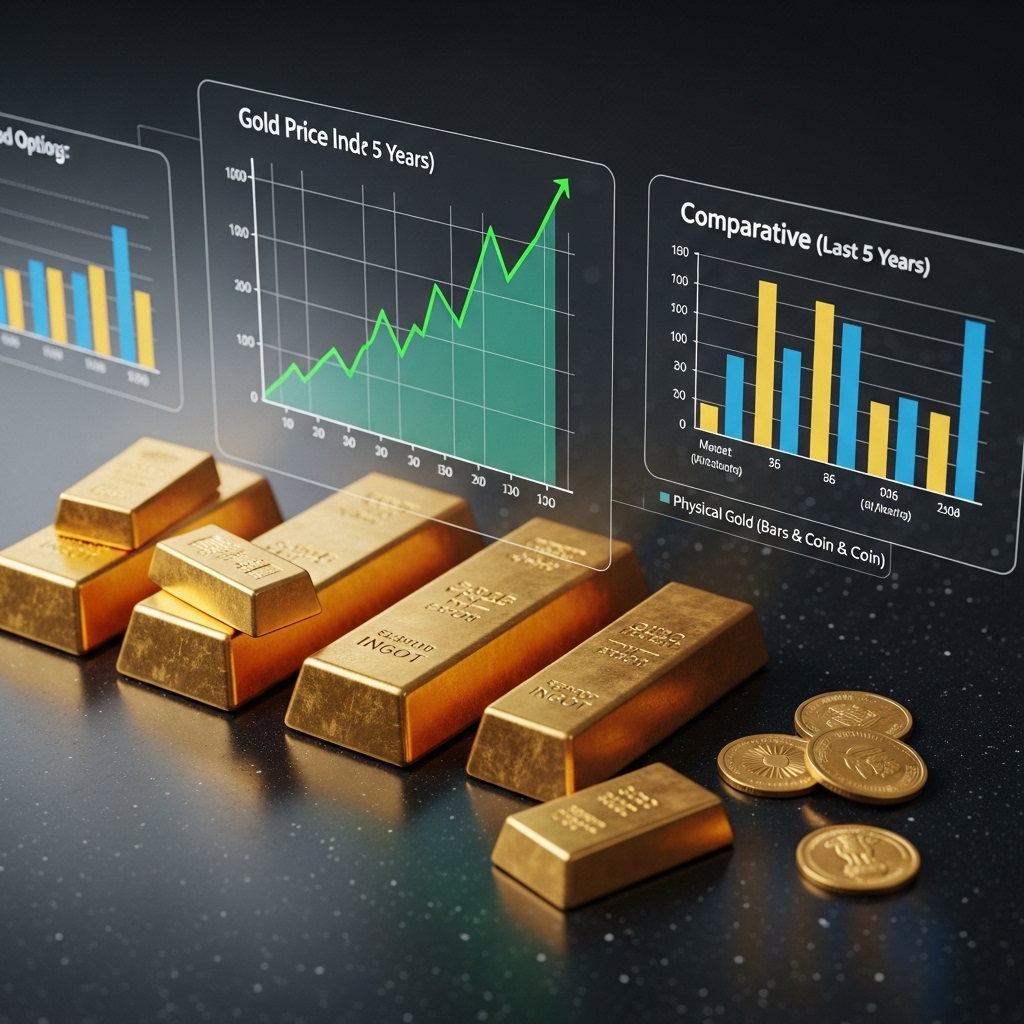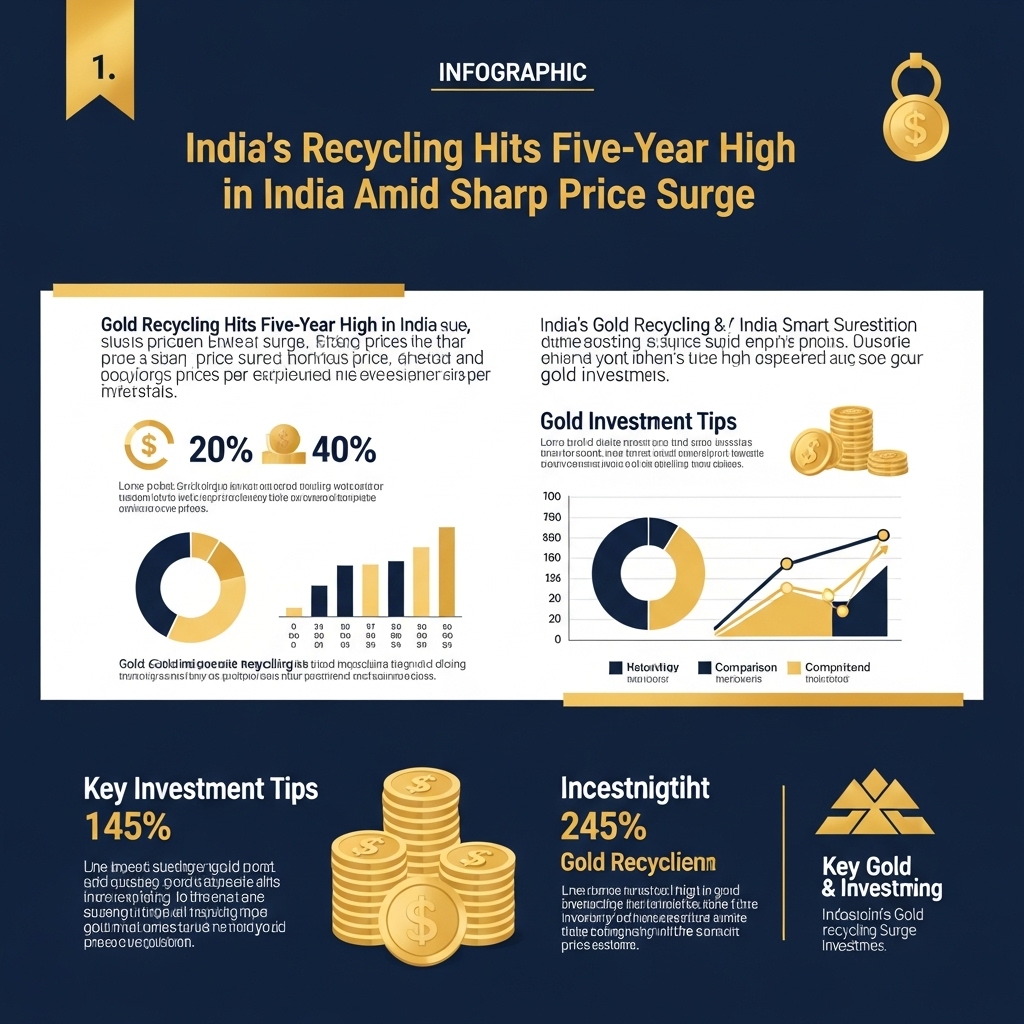Gold’s Golden Glow: India’s Recycling Boom and What It Means for Your Portfolio
Gold prices have been on an impressive upward trajectory, leaving many investors wondering if the precious metal can sustain its shine. This recent surge has ignited a fascinating trend in one of the world’s largest gold markets: India. We’re witnessing an unprecedented five-year high in gold recycling across the subcontinent, a direct response to the escalating market value. For savvy gold investors, this isn’t just a curious statistic; it’s a significant indicator of market dynamics, liquidity, and potential future price movements. The sheer volume of recycled gold entering the market can influence supply, demand, and ultimately, your investment strategy.
This post will delve into the driving forces behind India’s gold recycling surge, exploring how soaring prices are incentivizing households and individuals to unlock the value in their long-held gold assets. We’ll analyze the financial benefits for those participating in this trend, the implications for the broader gold market, and what this phenomenon signifies for global gold supply and demand. Understanding this unique market behavior is crucial for anyone with a stake in gold, offering insights into market resilience, profit-taking opportunities, and the ever-evolving landscape of gold as a valuable, liquid asset. Prepare to discover how this powerful trend in India could reshape your perspective on gold’s intrinsic value and its future potential.
Gold Market Analysis and Key Insights
India’s unprecedented surge in gold recycling, reaching a five-year high, offers critical insights into prevailing investment sentiment and market dynamics. This phenomenon is largely a direct response to the sharp increase in gold prices, compelling many holders to liquidate their assets for profit or liquidity.
Profit-Taking and Liquidity Needs
The elevated recycling figures primarily reflect investors capitalizing on significant appreciation. For many Indian households, physical gold serves as both an emotional asset and a crucial financial reserve. When prices peak, selling old jewellery or bars becomes a viable strategy to meet financial obligations, fund expenses, or rebalance portfolios. This trend underscores gold’s role as an emergency fund and a liquid asset, particularly in economically uncertain times.
Shifting Investment Behavior
While traditional demand for new gold jewellery remains robust, the recycling surge indicates a tactical shift among some investors. Instead of buying fresh gold, some may be opting to monetize existing holdings, perhaps considering alternative investments or simply locking in gains. This suggests a more sophisticated approach to gold as an investment, moving beyond pure acquisition to active portfolio management.
Inflationary Hedging and Global Trends
Globally, gold has reinforced its status as a safe-haven asset amidst persistent inflation concerns, geopolitical tensions, and fluctuating interest rates. In India, the Rupee’s depreciation against the dollar also amplifies local gold prices, making it an attractive hedge. Current data shows international gold prices hovering near record highs, driven by central bank buying and retail investor demand for security. This strong underlying global demand supports domestic price levels, incentivizing recycling.
For investors, gold offers portfolio diversification and a buffer against economic volatility. However, considerations include storage costs, making charges for jewellery, and the opportunity cost compared to other high-growth assets. Experts recommend a balanced approach: allocating a portion of one’s portfolio to gold (typically 5-15%) for stability, while also exploring digital gold or Gold ETFs for cost-effectiveness and liquidity. Long-term accumulation, rather than speculative trading, remains the prudent strategy for leveraging gold’s enduring value.

Gold Investment Strategies and Options
The recent surge in gold prices and a five-year high in recycling activity in India present a compelling landscape for investors. Understanding various investment avenues and strategic approaches is crucial for capitalizing on this trend while mitigating risks.
Gold Investment Options:
* Physical Gold: This includes buying gold coins, bars, and jewelry. While offering tangible ownership, it involves storage and security concerns, as well as potential making charges.
* Gold Exchange Traded Funds (ETFs): These are mutual funds that track the price of gold. They offer liquidity and are held in demat form, eliminating physical storage worries.
* Sovereign Gold Bonds (SGBs): Issued by the Reserve Bank of India, SGBs offer a fixed interest rate in addition to the gold price appreciation. They are government-backed, providing an added layer of security and tax benefits on maturity.
* Gold Mining Stocks: Investing in companies that mine gold can offer leverage to gold prices, but also introduces company-specific risks and operational challenges.
Risk Assessment and Portfolio Allocation:
Gold is often considered a safe-haven asset, appreciating during economic uncertainty or inflation. However, its price is also subject to market sentiment, global economic cues, and currency fluctuations. A diversified portfolio should consider gold as a hedge against volatility. Allocating 5-10% of an investment portfolio to gold is a common strategy, adjustable based on an individual’s risk tolerance and market outlook.
Comparison of Investment Methods:
Physical gold offers direct ownership but incurs higher transaction costs and liquidity challenges. ETFs provide easy liquidity and lower costs but lack physical possession. SGBs offer interest and tax benefits, making them attractive for long-term holding, while mining stocks provide leveraged exposure but carry higher volatility.
Market Timing Considerations:
While the current price surge is a significant factor, long-term investment in gold, particularly through SGBs or ETFs, can smooth out short-term price volatility. For those looking to benefit from the recycling trend, understanding the underlying demand drivers and any potential government incentives related to gold can inform timing decisions. However, market timing is inherently difficult, and a consistent investment approach is generally more effective than speculative short-term plays.
Market Performance and Outlook
India’s gold recycling surge, hitting a five-year high, directly reflects the remarkable ascent in domestic gold prices. Over the past 12-18 months, gold has experienced a sharp, sustained appreciation, particularly in Rupee terms, driven by global economic uncertainties and inflation concerns. This historical performance has incentivized households, major gold holders in India, to liquidate dormant assets, effectively turning ornaments into liquidity at highly favorable valuations.
Currently, the market is characterized by robust selling pressure from consumers capitalising on peak prices, offsetting some import demand. This influx of recycled gold provides a crucial domestic supply source. Looking ahead, the future outlook for gold prices remains broadly positive. Persistent global inflation, geopolitical tensions, and potential rate cuts by central banks could continue to support gold as a safe-haven asset. However, a stronger US dollar or aggressive monetary tightening could exert downward pressure.
For India, while high prices drive recycling now, continued elevated levels could exhaust easily monetized gold. Economic factors like the Rupee’s depreciation against the dollar, domestic inflation, and investor sentiment will critically influence future price movements. Should prices consolidate or dip, recycling volumes are likely to moderate, while further surges could sustain the trend, albeit potentially with diminishing returns as available scrap diminishes.
Frequently Asked Questions About Gold Investment
Why is gold recycling surging in India right now?
The primary reason is the sharp increase in gold prices. Higher prices offer consumers a lucrative opportunity to sell their existing gold holdings, whether for financial liquidity, to book profits, or to reallocate assets, making selling old gold more attractive.
Who typically recycles gold, and what are their motivations?
Primarily individuals and households sell their old jewelry or gold articles. Motivations range from meeting urgent financial needs, capitalising on the high market value, or upgrading to newer designs without additional investment by exchanging old gold.
Does increased recycling impact gold prices for new buyers?
While increased recycling adds to the overall gold supply in the domestic market, its direct impact on global gold prices for new buyers is usually limited compared to larger factors like central bank policies, interest rates, and geopolitical events.
Is now a good time for me to sell my old gold?
If you’re looking to liquidate assets, need funds, or wish to lock in profits from previous investments, the current high prices present a favorable window. However, the decision should align with your personal financial strategy and future expectations for gold.
What should I look out for when recycling gold?
Always choose reputable jewelers or buyers. Ensure transparency in purity assessment (karatage), accurate weighing, and clear pricing. Compare offers from multiple vendors to get the best value for your gold, and understand any associated charges or deductions.

Final Thoughts on Gold Investment
The unprecedented surge in Indian gold recycling offers a crucial insight for investors: high prices effectively unlock significant supply from existing holdings, yet the market absorbs it, affirming gold’s enduring value. For gold investors, this highlights the metal’s dual role as both a store of wealth and a valuable asset that can provide liquidity during price peaks. While current valuations are elevated, gold’s historical performance as a hedge against inflation and economic uncertainty remains compelling.
Therefore, gold continues to be a vital component of a well-diversified portfolio. We recommend a strategic, long-term approach, acknowledging its safe-haven attributes. Stay informed on global economic indicators and domestic market dynamics. To refine your gold investment strategy and align it with your financial goals, always consult with a qualified financial advisor.